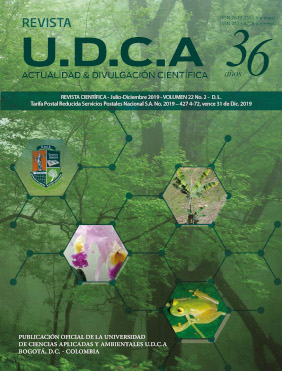Modelado del requerimiento energético y del tamaño de partícula en la molienda de bolas del grano de amaranto
Modeling of particle size and energetic requirement in amaranth grain ball-milling
Contenido principal del artículo
Resumen
La harina de amaranto es de alto valor nutricional, convirtiéndola en un alimento potencial. La molienda de los granos es una operación necesaria, para brindarle a los productos alimenticios unas adecuadas propiedades físicas. Para analizar el efecto de la velocidad y el tiempo de molienda sobre el diámetro de particular y las propiedades físicas de la harina obtenida por molienda de bolas, se usó un diseño experimental Doehlert, con réplica en el punto central. En las pruebas de molinería se tuvo en cuenta la relación masa de bolas/masa de muestra (R1:5). Las curvas de granulometría de cada punto del diseño experimental fueron modeladas por las ecuaciones de Rosin-Ramler-Bennet y Holmes-Hukki. Se encontró un efecto muy significativo de la velocidad de molienda sobre los diámetros característicos (D50, D63 y D80). El modelo de Rosin-Ramler-Bennet ajustó satisfactoriamente (r2>0.99), además, se obtuvo el índice de homogeneidad (n1), el cual, fue afectado directamente por la energía de molienda. El uso del modelo de Holmes-Hukki permitió relacionar el diámetro de partícula con la energía de molienda y se logró observar una región crítica entre 100μm y 200μm, donde hay una reducción en la eficiencia de la reducción de tamaño de partícula. El exceso de energía liberada en la región crítica causó el descenso en la cristalinidad del almidón y provocó cambios en la estructura de las proteínas, lo cual, modificó las propiedades físicas de la harina. El Molino planetario es una técnica emergente y efectiva para modificar las propiedades funcionales en el desarrollo de nuevo productos alimenticios.
Palabras clave:
Descargas
Datos de publicación
Perfil evaluadores/as N/D
Declaraciones de autoría
- Sociedad académica
- Universidad de Ciencias Aplicadas UDCA
- Editorial
- Universidad de Ciencias Aplicadas y Ambientales U.D.C.A
Detalles del artículo
Referencias (VER)
CAJAS, J.; LOUBES, M.; TOLABA, M. 2015. Efecto de la granulometría de la harina de arroz en el volumen y alveolado del pan de molde libre de gluten. La Alimentación Latinoamericana. 318:64-68.
CERÓN, L.; GUERRA, V.; LEGARDA, J.; ENRÍQUEZ, M.; PISMAG, Y. 2016. Effect of extrusion on the physicochemical characteristics of quinoa flour (Chenopodium quinoa Willd). Biotecnología en el sector Agropecuario y Agroindustrial. 14(2):92-99. http://dx.doi.org/10.18684/BSAA(14)92-99
DE LA CRUZ, N.; CERÓN, A.; GARCÉS, L. 2015. Analysis and modeling of the granularity in the coffee husk (Coffea arabica L.) variety Castillo. Production + Clean. 10(2):80-91.
DHARMARAJ, U.; MEERA, M.; REDDY, S.; MALLESHI, N. 2015. Influence of hydrothermal processing on functional properties and grain morphology of finger millet. J. Food Science Technology, 52:1361-1371. https://doi.org/10.1007/s13197-013-1159-8
GHORBANNEZHAD, P.; BAY, A.; YOLMEH, M.; YADOLLAHI, R.; MOGHADAM, J. 2016. Optimization of coagulation–flocculation process for medium density fiberboard (MDF) wastewater through response surface methodology. Desalination and Water Treatment. 57(56):916-931. https://doi.org/10.1080/19443994.2016.1170636.
GUERRINI, G.; BRUZZONE, A.; CRENNA, F. 2017. Single grain grinding: an experimental and FEM assessment. Procedia CIRP. 62:287-292. https://doi.org/10.1016/j.procir.2016.07.082
HUANG, Z-Q.; LU, J-P.; LI, X-H.; TONG, Z. 2007. Effect of mechanical activation on physicochemical properties and structure of cassava starch. Carbohydrate Polymer. 68(1):128-135. https://doi.org/10.1016/j.carbpol.2006.07.017
IVANOVA, T. 2016. Design and technology support of the grinding process for heavily-machined steel sheets. Procedia Engineering. 150:782-788. https://doi.org/10.1016/j.proeng.2016.07.112
KOWALSKI, R.; MEDINA, G.; THAPA, B.; MURPHY, K.; GANJYAL, G. 2016. Extrusion processing characteristics of quinoa (Chenopodium quinoa Willd) var. Cherry Vanilla. J. Cereal Science. 70:91-98. https://doi.org/10.1016/j.jcs.2016.05.024
LIMIN, D.; CHANGWEI, L.; JUN, Z.; FANG, C. 2018. Preparation and characterization of starch nanocrystals combining ball milling with acid hydrolysis. Carbohydrate Polymers. 180:122-127. https://doi.org/10.1016/j.carbpol.2017.10.015
NAWAZ, M.; FUKAI, S.; BHANDARI, B. 2016. Effect of alkali treatment on the milled grain surface protein and physicochemical properties of two contrasting rice varieties. J. Cereal Science. 72:16-23. https://doi.org/10.1016/j.jcs.2016.09.009
RHODES, M. 2008. Introduction to Particle Technology. 2nd ed. John Wiley & Sons, Chichester, UK. 450p.
ROA, D.; SANTAGAPITA, P.; BUERA, P.; TOLABA, M. 2014. Ball milling of Amaranth starch-enriched fraction. Changes on particle size, starch crystallinity, and functionality as a function of milling energy. Food and Bioprocess Technology. 7(9):2723-2731. https://doi.org/10.1007/s11947-014-1283-0
ROA, D.; GONZALEZ, C.; CALDERON, Y. 2017. Control of abrasive grinding of amaranth grain to obtain two fractions with industrial potential. Biotecnología en el Sector Agropecuario y Agroindustrial. 15(ed. especial):59-66. http://dx.doi.org/10.18684/BSAA(Edición%20Especial)59-66
SANCHEZ, H.; GONZALEZ, R.; OSELLA, C.; TORRES, R.; DE LA TORRE, M. 2008. Elaboration of bread without gluten from extruded rice flours. Ciencia y Tecnologia Alimentaria. 6(2):109-116.
SURESH, D.; AASITHOSH, A.; PREETHAM-KUMAR, K.; USHA, D. 2016. Evaluation of roller milling potential of amaranth grains. J. Cereal Science. 73:55-61. https://doi.org/10.1016/j.jcs.2016.11.006
TOVAR, C.; PERAFÁN, E.; ENRIQUEZ, M.; PISMAG, Y. 2017. Extrusion process effect evaluation on normal and germinated flour quinoa (Chenopodium quinoa Willd). Biotecnología en el Sector Agropecuario y Agroindustrial. 15(2):30-38. http://dx.doi.org/10.18684/BSAA(15)30-38
YAOZHONG, LV; LIMING ZHANG; MENGNAN LI; XIHONG HE; LIMIN, HAO; YUJIE, DAI. 2019. Physicochemical properties and digestibility of potato starch treated by ball milling with tea polyphenols. Imternal J. Biological Macromolecules. 129:207-213. https://doi.org/10.1016/j.ijbiomac.2019.02.028
ZHANG, Z.; ZHAO, S.; XIONG, S. 2010. Morphology and physicochemical properties of mechanically activated rice starch. Carbohydrate Polymer. 79(20):341-348. https://doi.org/10.1016/j.carbpol.2009.08.016







